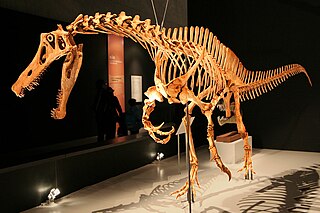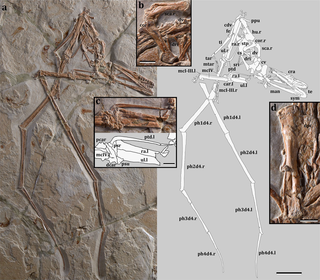
Irritator is a genus of spinosaurid dinosaur that lived in what is now Brazil during the Albian stage of the Early Cretaceous Period, about 113 to 110 million years ago. It is known from a nearly complete skull found in the Romualdo Formation of the Araripe Basin. Fossil dealers had acquired this skull and sold it to the State Museum of Natural History Stuttgart. In 1996, the specimen became the holotype of the type species Irritator challengeri. The genus name comes from the word "irritation", reflecting the feelings of paleontologists who found the skull had been heavily damaged and altered by the collectors. The species name is a homage to the fictional character Professor Challenger from Arthur Conan Doyle's novels.

Cristatusaurus is a genus of theropod dinosaur that lived during the Early Cretaceous Period of what is now Niger, 112 million years ago. It was a baryonychine member of the Spinosauridae, a group of large bipedal carnivores with well-built forelimbs and elongated, crocodile-like skulls. The type species Cristatusaurus lapparenti was named in 1998 by scientists Philippe Taquet and Dale Russell, on the basis of jaw bones and some vertebrae. Two claw fossils were also later assigned to Cristatusaurus. The animal's generic name, which means "crested reptile", alludes to a sagittal crest on top of its snout; while the specific name is in honor of the French paleontologist Albert-Félix de Lapparent. Cristatusaurus is known from the Albian to Aptian Elrhaz Formation, where it would have coexisted with sauropod and iguanodontian dinosaurs, other theropods, and various crocodylomorphs.

Guarinisuchus is an extinct genus of marine crocodyliform from the Early Paleocene 62 million years ago of the Maria Farinha Formation, Brazil. The type species is G. munizi. It was a dominant predator in its environment, and probably reached a length of 3 metres (9.8 ft). Guarinisuchus appears to be closely related to marine crocodylomorphs found in Africa, which supports the hypothesis that the group originated in Africa and migrated to South America before spreading into the waters off the North American coast.

Peirosauridae is a Gondwanan family of mesoeucrocodylians that lived during the Cretaceous period. It was a clade of terrestrial crocodyliforms that evolved a rather dog-like skull, and were terrestrial carnivores. It was phylogenetically defined in 2004 as the most recent common ancestor of Peirosaurus and Lomasuchinae and all of its descendants. Lomasuchinae is a subfamily of peirosaurids that includes the genus Lomasuchus.

Sphagesaurus is an extinct genus of sphagesaurid notosuchian crocodylomorph from the Late Cretaceous of southwest São Paulo, southern Brazil.
The Adamantina Formation is a geological formation in the Bauru Basin of western São Paulo state, in southeastern Brazil.

Barinasuchus is an extinct genus of sebecid mesoeucrocodylian. Its fossils have been found in middle Eocene-age rocks of the Divisadero Largo Formation of Argentina, middle Miocene-age rocks of the Ipururo Formation of Peru, and middle Miocene-age rocks of the Parángula Formation of Venezuela.

Pholidosauridae is an extinct family of aquatic neosuchian mesoeucrocodylian crocodylomorphs. Fossils have been found in Europe, Africa, North America and South America. The pholidosaurids first appeared in the fossil record during the Bathonian stage of the Middle Jurassic. Jouve & Jalil (2020) described postcranial material of a pholidosaurid from the Paleocene (Danian) of Ouled Abdoun Basin (Morocco), representing the most recent record of the family. The authors also reinterpreted putative Maastrichtian dyrosaurid Sabinosuchus as a pholidosaurid, and argued that at least two independent pholidosaurid lineages reached the Maastrichtian, among which one survived the Cretaceous–Paleogene extinction event. Before the publication of this study it was thought that the family became extinct during the Late Turonian stage of the Late Cretaceous.

Susisuchus is an extinct genus of neosuchian mesoeucrocodylian crocodyliform from the Early Cretaceous of Brazil. Fossils have been found from the Nova Olinda Member of the Aptian-age Crato Formation in the Araripe and Lima Campos Basins of northeastern Brazil. Named in 2003, Susisuchus is the sole member of the family Susisuchidae, and is closely related to the clade Eusuchia, which includes living crocodilians. The type species is S. anatoceps, known from a single partial articulated skeleton that preserves some soft tissue. A second species, S. jaguaribensis, was named in 2009 from fragmentary remains.

Oxalaia is a genus of spinosaurid dinosaur that lived in what is now the Northeast Region of Brazil during the Cenomanian stage of the Late Cretaceous period, sometime between 100.5 and 93.9 million years ago. Its only known fossils were found in 1999 on Cajual Island in the rocks of the Alcântara Formation, which is known for its abundance of fragmentary, isolated fossil specimens. The remains of Oxalaia were described in 2011 by Brazilian palaeontologist Alexander Kellner and colleagues, who assigned the specimens to a new genus containing one species, Oxalaia quilombensis. The species name refers to the Brazilian quilombo settlements. Oxalaia quilombensis is the eighth officially named theropod species from Brazil and the largest carnivorous dinosaur discovered there. It is closely related to the African genus Spinosaurus, and/or may be a junior synonym of this taxon.
The Alcântara Formation is a geological formation in northeastern Brazil whose strata date back to the Cenomanian of the Late Cretaceous.
The year 2011 in Archosaur paleontology was eventful. Archosaurs include the only living dinosaur group — birds — and the reptile crocodilians, plus all extinct dinosaurs, extinct crocodilian relatives, and pterosaurs. Archosaur palaeontology is the scientific study of those animals, especially as they existed before the Holocene Epoch began about 11,700 years ago. The year 2011 in paleontology included various significant developments regarding archosaurs.
The year 2009 in Archosaur paleontology was eventful. Archosaurs include the only living dinosaur group — birds — and the reptile crocodilians, plus all extinct dinosaurs, extinct crocodilian relatives, and pterosaurs. Archosaur paleontology is the scientific study of those animals, especially as they existed before the Holocene Epoch began about 11,700 years ago. The year 2009 in paleontology included various significant developments regarding archosaurs.
Deltasuchus is a genus of neosuchian crocodyliform from the Late Cretaceous of Texas, specifically in the Woodbine Formation, which was a part of the Appalachian continent during the Cretaceous. It is known from one species, D. motherali, named in 2017 by Thomas Adams, Christopher Noto, and Stephanie Drumheller. It was a large crocodyliform with an estimated total body length of 5.6–6 metres (18–20 ft). In 2021, new material was described, allowing Deltasuchus to be placed within the family Paluxysuchidae as the sister taxon to Paluxysuchus.

Atlanticopristis is an extinct genus of sclerorhynchid that lived during the Middle Cretaceous (Cenomanian) of what is now the Northeast Region of Brazil, between 100.5 and 93.9 million years ago. Fourteen fossil teeth from Atlanticopristis were found in the Alcântara Formation, and referred to the closely related Onchopristis in 2007; a redescription in 2008 by Brazilian paleontologists Manuel Medeiros and Agostinha Pereira assigned it to a new genus containing one species, Atlanticopristis equatorialis.
The Presidente Prudente Formation is a geological formation of the Bauru Group in the Paraná Basin, located in Brazil whose strata date back to the Late Campanian to Early Maastrichtian.
Itapeuasaurus is a genus of rebbachisaurid sauropod dinosaur from the Alcântara Formation of Maranhão in Brazil. The type and only species is Itapeuasaurus cajapioensis. It is the most complete Cenomanian-aged diplodocoid known from South America and it is also the first reported Cenomanian-aged rebbachisaurid discovered in South America.

Mimodactylus is a genus of istiodactyliform pterosaur that lived in what is now Lebanon during the Late Cretaceous, 95 million years ago. The only known specimen was discovered in a limestone quarry near the town of Hjoula, belonging to the Sannine Formation. The owner of the quarry allowed the specimen to be prepared and scientifically described by an international team of researchers, and when it was eventually sold, the buyer donated it to the MIM Museum in Beirut. In 2019, the researchers named the new genus and species Mimodactylus libanensis; the generic name refers to the MIM Museum, combined with the Greek word daktylos for "digit", and the specific name refers to Lebanon. The well-preserved holotype specimen is the first complete pterosaur from the Afro-Arabian continent, and the third pterosaur fossil known from Lebanon.











